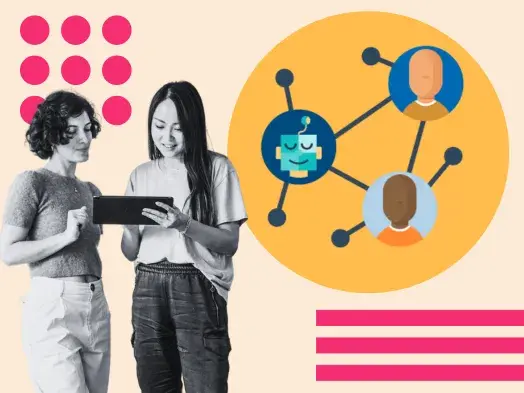How Can Chatbots Improve User Experience
- Providing customer support.
- Offering quick responses to simple questions.
- Reducing customer wait time.
- Relieving customer service pressures.
- Offering always on customer service.
- Generating high quality leads.
- Obtain informative data about how your business is faring.
- Provide personalization.
1. Providing customer support.
The most significant way that chatbots improve the user experience is by simply providing additional avenues for customer support. With chatbots, customers are given another channel to contact your business aside from over the phone, via email, or visiting a store front.
Having an additional option increases convenience, as most chatbots can easily be accessed via mobile device or computer, meaning that consumers can find resolutions from wherever they are so long as they have a compatible device.
71% of customers already expect brands to offer customer support over messaging channels — improve your user experience by meeting an existing customer desire.
2. Offering quick responses to simple questions.
Customers want quick responses from support teams when they reach out with simple questions. But, as many support teams handle a large volume of requests, it’s not always feasible to immediately answer questions, regardless of how simple they are.
Chatbots are a solution to this issue, as they can handle multiple conversations at once and provide quick responses to all queries, especially when it comes to answering simple questions.
For example, instead of calling your business to ask how long you’re open and being placed on hold, a Facebook Messenger chatbot can quickly respond with your open hours. If a customer were to ask a question that required hands-on help from a human rep, the chatbot would also know how to adequately transfer the query to an available agent.
3. Reducing customer wait time.
It’s well known that a top customer frustration is long wait times, as people want quick solutions without having to be on hold or wait to receive an email reply.
Chatbots help improve this aspect of the customer experience. Regardless of the type of question, a chatbot can be there to immediately assist customers when they reach out, whether it’s to provide a simple solution or transfer them to a live agent better suited to help.
When speaking with chatbots, 59% of survey respondents expect a response within 5 seconds or less — something that would be difficult for a human to meet. As such, adopting chatbots will help you speak to this customer desire.
4. Relieving customer service pressures.
When chatbots are trained to answer common customer queries and provide quick solutions, support teams are relieved of the pressure that comes from juggling low-touch issues and higher-priority issues that need more attention. In fact, 43% of businesses say they adopted chatbots because they wanted to save time with automated customer service.
Reps can instead focus on high-impact, time sensitive matters, while chatbots answer standard questions like providing your business’ open hours.
5. Offering always on customer service.
Another way that chatbots supplement the customer experience is by offering always on, around the clock customer support — in fact, 64% of customers say that 24/7 service is the best feature of chatbots.
When support is always available, customers no longer have to wait until your business reopens to get a response because a chatbot is there to respond to a query. If a serious issue were to arise when your human support reps aren’t online, a chatbot could even give the customer a timeline for when they can expect to speak with an agent. Without a chatbot, the customer may be sitting around waiting to hear back from someone, wondering if their query had even been received in the first place.
6. Generating high quality leads.
Through conversations with customers, chatbots learn more about them and where they stand in relation to your business — like, are they qualified leads, or simply interested prospects.
In this regard, chatbots can help you improve the user experience by collecting information on leads and assessing their level of interest in what you offer. Then, when you know where they stand, you can serve them with additional business materials that you know speak to their needs.
Drift surveyed B2B professionals across various industries and 54.8% of respondents reported that they receive a greater volume of high-quality leads from using conversational tools.
7. Obtain informative data about how your business is fairing.
Just as you can generate high-quality leads from chatbots, you can also obtain useful information about how your business is fairing in the eyes of your customers.
When customers send messages, you can learn about issues they face. If you notice a trend in similar issues, you can use this data to update FAQ pages, product instructions, and knowledge bases, or train chatbots to respond to these questions so your customers face less issues.
You’ll also learn how customers speak about your products and how they discuss them, giving you valuable insight into customer perception of what you offer. This can help you tailor your business materials, like marketing content, to use language that your customers use and can easily relate to.
8. Provide personalization.
Chatbots personalize a user experience, tailoring the conversation to match the customers exact need.
With personalization, chatbots can suggest products to customers based on their queries, provide offers based on their buyer's journey, and even suggest the best possible next source of action depending on their need.
Over To You
Deciding to leverage chatbots in your customer experience strategy depends entirely on your business needs. If you choose to do so, you’ll likely find your support reps being able to spend more time on time-sensitive issues, satisfied customers that find quick solutions, and you’ll generate an in-depth understanding of your audience that can help you better serve them.
Chatbots






![How Consumers Use Live Chat for Customer Service [New Data]](https://53.fs1.hubspotusercontent-na1.net/hubfs/53/live%20chat%20for%20customer%20service_featured%20image.jpg)
![What is Proactive Live Chat? [+ How to Implement It and 7 Tools]](https://53.fs1.hubspotusercontent-na1.net/hubfs/53/proactive%20live%20chat%20examples.jpg)
![Do Consumers Prefer to Talk to Chatbots or Humans for Service Needs [New Data]](https://53.fs1.hubspotusercontent-na1.net/hubfs/53/CHATBOTS%20(1).jpg)

